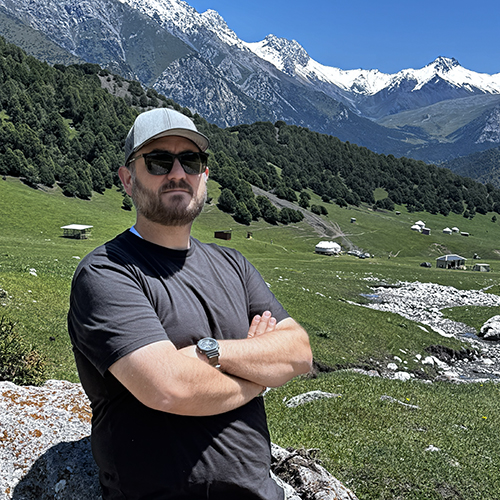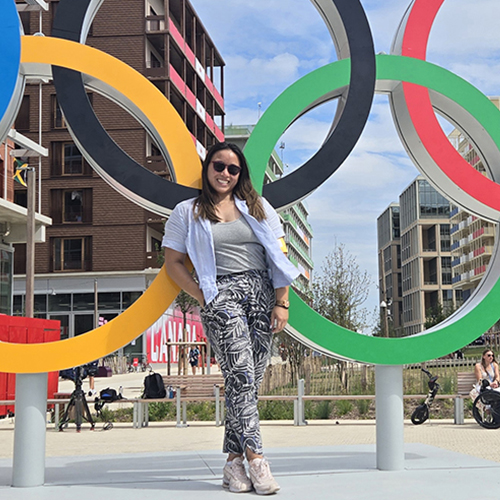Two middle school teachers stand in a UW laboratory classroom, armed with slug mucous and a homemade device, the “stick-o-meter.” They are about to compare the holding power of slug slime and glue stick. It’s just the sort of experiment their nearly teenage students would love.
The teachers are participants in the UW’s Summer Institute in Life Science, a three-week program for fifth through eighth grade teachers that fosters improvement of science education. The program is offered by the UW Biology Program with funding from the Howard Hughes Medical Institute.
Field trips and laboratory experiments—with and without slugs—are at the heart of the program. “We teach by doing, not by lecturing,” says Helen Buttemer, coordinator of biology programs for teachers and director of the summer institute. “Everything is done in a Socratic fashion, engaging in problem solving with the teachers.”
Both Buttemer and Ola Edwards, who co-teaches the institute, have experience teaching in middle schools and know the challenges involved.
“Often there is no inquiry at all in middle school sciences classes,” says Edwards. “The students just follow instructions. Mostly, they merely observe and confirm already known ‘facts’. That’s not what science is about.”
That description sounds familiar to many of the institute participants. Even those with a life sciences background have avoided hands-on experiments in the classroom. “They come to the institute with this preconception that science is this huge encyclopedia of information and they’ll never know enough to teach it,” says Buttemer. “One of our biggest tasks is to help them relax about that. We want them to let go of the idea that they need to be an expert to teach good science. Science isn’t only knowing the answer. It’s also about formulating questions and trying to find answers.”
That’s where the slugs—and crayfish and yogurt and other organisms—come in. One full week of the institute is devoted to scientific inquiry, with the teachers assigned to formulate a question about an organism and figure out how to answer it experimentally. “At the end of the week, they present their research,” says Buttemer, “and in the process, they discover how much fun research can be.”
That was certainly the case for Veronica Mantel, a seventh grade teacher who has just moved to the area. “I learned how to ask questions, how to inquire, how to experiment,” she says. “You can read information from a book, you can also teach the information to students, but until you can think like a scientist you can never truly be ‘in the game.’ Now I feel like I get it and can be a much better teacher.”
Another week is spent studying ecosystems, culminating in a marathon field trip to eastern Washington, with numerous stops along the way. “We leave town at 7 a.m. and head for the Asahel Curtis Nature Reserve, where we can look at the rainforest and a salmon stream,” says Edwards, who leads the trip. “Then we continue on to Alpental, which is a high elevation forest. Our next stop is the Cle Elum Bakery—this is very important—before continuing on to Gingko State Park, where many trees were buried by lava and petrified. It’s an extraordinary demonstration of the lava floods that covered most of eastern Washington and changed the landscape. Next we head for Frenchman’s Coolee, carved by ice age floods, where we go down to the Columbia River and jump in. Our last stop is a walk through the sagebrush desert.”
Sound like an incredibly long day? It is. By the time the participants return to Seattle at about 10 p.m., they have discussed genetically engineered salmon, high elevation logging, desert environments, and dozens of other ecological issues.
Edwards sees the field trip as a golden opportunity to get teachers hooked on the natural world of Washington State. “Teachers need an opportunity to fall in love with nature,” she says, “because if they don’t, their students—most of whom are urban kids—won’t either.”
A final unit on cellular and molecular biology, led by Maureen Munn and Megan Brown of the UW’s Genome Center, rounds out the program. Teachers leave the institute with armloads of creative activities and experiments—and the confidence to try new approaches.
“I have shied away from using living organisms in the classroom,” says Mantel. “This class has really helped strip me of any previously held apprehension. My comfort level has increased dramatically.”
Dana Ladowski, an eighth grade teacher at Cedarcrest Junior High School in Spanaway, says she “will be doing more inquiry based lab experiments where I am the facilitator, not the director giving step-by-step direction.” And if students’ experiments do not go as planned? “I’ve learned that all outcomes are a learning experience whether they match the prediction or not,” says Ladowski.
Even teachers with minimal life sciences experience, like sixth grade teacher Mike Thompson of the Saint Thomas More School in Lynnwood, feel confident by the end of the institute. Last year was Thompson’s first as a teacher, and he admits to using a lot of “canned” experiments.
“The kids would ask, ‘Why can’t we do our own experiments?’” Thompson recalls. “I didn’t let them because I could barely make the experiments work myself. Now I realize that experiments don’t have go off textbook perfect. If you can get the students off to a good start and help them along to within sight of the finish line, they can figure out what worked, what didn’t, and why. And that’s really what science is— inquiry, experimentation, and reflection on your results. It’s the thinking that happens along the way that matters.”
Now Thompson is eager to provide the materials and guidance that will enable students to do experiments themselves. “They really want that freedom,” he says, “and it makes science way more fun for them.”
It sounds like Thompson’s students—and the students of the other 19 teachers at the 2002 institute—have much to look forward to this year. And that’s really what the institute is all about.
“I can’t believe that I learned so much,” says Mantel. “I wish every science teacher could have this opportunity. Just think of how this could benefit the kids!”
More Stories

Through Soil Science, an Adventure in Kyrgyzstan
Chemistry PhD alum Jonathan Cox spent most of 2025 in Kyrgyzstan, helping farmers improve their soil—and their crops—through soil testing.

A Sports Obsession Inspires a Career
Thuc Nhi Nguyen got her start the UW Daily. Now she's a sports reporter for Los Angeles Times, writing about the Lakers and the Olympics.

A Healing Heart Returns
In February, the UW Symphony will perform a symphony that Coast Salish elder Vi Hilbert commissioned years ago to heal the world after the heartbreak of 9/11. The symphony was first performed by the Seattle Symphony in 2006.